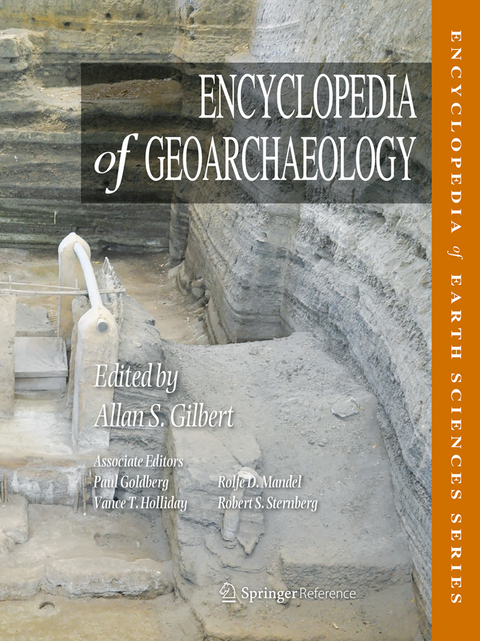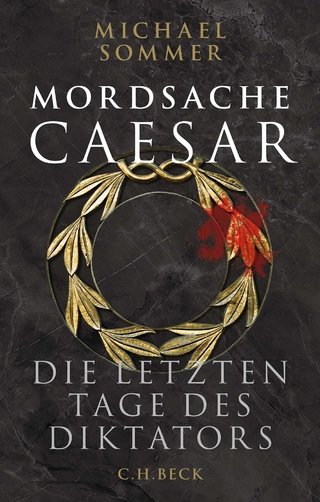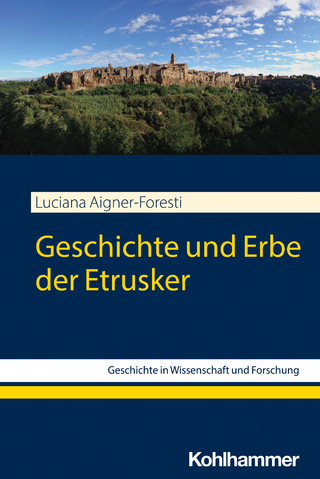
Encyclopedia of Geoarchaeology
Springer (Verlag)
978-94-007-4828-6 (ISBN)
- Titel erscheint in neuer Auflage
- Artikel merken
Zu diesem Buch erhalten Sie kostenlos ein eBook dazu.
- Renders the complex interdisciplinary science of geoarchaeology in simple, understandable terms
- Presents a comprehensive compendium that ensures fast access to information
- Supports specialists, practitioners and members of the public through definitions, technique descriptions and more
- Demonstrates the connections between culture and environment, emphasizing the links between geoscience and behavioral science
- Investigates the collaboration of archaeology and earth science to discover past human behavior
Geoarchaeology is the archaeological subfield that focuses on archaeological information retrieval and problem solving utilizing the methods of geological investigation. Archaeological recovery and analysis are already geoarchaeological in the most fundamental sense because buried remains are contained within and removed from an essentially geological context. Yet geoarchaeological research goes beyond this simple relationship and attempts to build collaborative links between specialists in archaeology and the earth sciences to produce new knowledge about past human behavior using the technical information and methods of the geosciences.
The principal goals of geoarchaeology lie in understanding the relationships between humans and their environment. These goals include (1) how cultures adjust to their ecosystem through time, (2) what earth science factors were related to the evolutionary emergence of humankind, and (3) which methodological tools involving analysis of sediments and landforms, documentation and explanation of change in buried materials, and measurement of time will allow access to new aspects of the past.
This encyclopedia defines terms, introduces problems, describes techniques, and discusses theory and strategy, all in a format designed to make specialized details accessible to the public as well as practitioners. It covers subjects in environmental archaeology, dating, materials analysis, and paleoecology, all of which represent different sources of specialist knowledge that must be shared in order to reconstruct, analyze, and explain the record of the human past. It will not specifically cover sites, civilizations, and ancient cultures, etc., that are better described in other encyclopedias of world archaeology.
Allan S. Gilbert is Professor of Anthropology at Fordham University in the Bronx, New York. He holds a B.A. from Rutgers University, and his M.A., M.Phil., and Ph.D. were earned at Columbia University. His areas of research interest include the Near East (late prehistory and early historic periods) as well as the Middle Atlantic region of the U.S. (historical archaeology). His specializations are in archaeozoology of the Near East and geoarchaeology, especially mineralogy and compositional analysis of pottery and building materials. Publications have covered a range of subjects, including ancient pastoralism, faunal quantification, skeletal microanatomy, brick geochemistry, and two co-edited volumes on the marine geology and geoarchaeology of the Black Sea basin.
Paul Goldberg is Professor Emeritus in the Department of Archaeology, Boston University. He obtained his B.A. in geology from the University of Colorado, Boulder, and M.S. and Ph.D. degrees in geology from The University of Michigan. He is currently Professorial Research Professor in the Centre for Archaeological Science at the University of Wollongong, and member of the Center for Archaeological Science at the University of Tübingen. His research interests focus on the application of micromorphology to the study of landscapes, soils, and site formation processes at archaeological sites. Most of his research is in the Old World, particularly cave sediments from China, France, Germany, Spain, Israel, and most recently Flores.
Vance T. Holliday is a Professor of Anthropology and Geosciences at the University of Arizona. He has a B.A. in Anthropology (with Honors) from the University of Texas at Austin, an MA in Museum Science (with Soil Science minor) from Texas Tech University, and a PhD in Geological Sciences from the University of Colorado. His research and teaching deals with geoarchaeology, the peopling of the New World, Quaternary geology, and soil geomorphology. Most of his field work has focused on the Great Plains and Southwest of North America, but also includes southwestern Russia. He is Director of the Argonaut Archaeological Research Fund, which is devoted to research on the Paleoindian archaeology and geoarchaeology of the Southwest.
Rolfe D. Mandel is Distinguished Professor of Anthropology at the University of Kansas, and Senior Scientist and Executive Director of the Odyssey Geoarchaeology Research Program at the Kansas Geological Survey in Lawrence, Kansas. He holds a B.A. from the University of Texas at Austin, and an M.A. and Ph.D. from the University of Kansas. From 1999-2004, he served as Editor-in-Chief of Geoarchaeology: An International Journal. His research spans a wide range of topics including geoarchaeology, paleopedology, late-Quaternary landscape evolution, and paleoenvironmental reconstruction. He has spent most of career working with archaeologists in the midcontinent of North America and the eastern Mediterranean, and during the past 15 years he has focused on the use of geoscientific methods to search for the earliest evidence of humans in the Central Great Plains and Midwest.
Robert S. Sternberg is Professor of Geosciences at Franklin & Marshall College, a small liberal arts college in Lancaster, Pennsylvania. He holds a B.S. from Cornell University in engineering physics, and M.S. and Ph.D. degrees from the University of Arizona in geophysics. His research applies magnetic methods to archaeology: archaeomagnetic secular variation and dating; magnetic prospection, and magnetic properties of obsidian. He has been associated for many years with the Society for Archaeological Sciences, currently as the General Secretary.
'Ain Ghazal
Akrotiri Aetokremno, Cyprus
Alluvial Settings
Amino Acid Racemization
Analysis of Carbon, Nitrogen, pH, Phosphorus, and Carbonates as Tools in Geoarchaeological Research
Anthrosols
40Ar/39Ar and K-Ar Geochronology
Archaeological Stratigraphy
Archaeomagnetic Dating
Archaeomineralogy
Archaeoseismology
Arctic Geoarchaeology: Site Formation Processes
Artifact Conservation
Atapuerca
Beringia, Geoarchaeology
Big Eddy Site, Missouri
Blombos Cave
Boxgrove
Built Environment
Burned-Rock Features
Cactus Hill, Virginia
Caves and Aqueducts in the Ancient World
Casper Site, Wyoming
Catalhoyuk
Cave Settings
Ceramics
Ceren
Chemical Alteration
Chronostratigraphy
Climatostratigraphy (Climostratigraphy)
Coastal Settings
Colluvial Settings
Cosmogenic Isotopic Dating
Data Visualization
Dendrochronology
Dmanisi
Dolni Vestonice, Pavlov, Milovice
Dumps and Landfill
Dust Cave, Alabama
Eastern Sahara: Combined Prehistoric Expedition
El Miron Cave
Electrical Resistivity and Electromagnetism
Electron Probe Microanalyzer
Electron Spin Resonance (ESR) in Archaeological Context
Eolian Settings: Loess
Eolian Settings: Sand
Ethnogeoarchaeology
Experimental Geoarchaeology
Field Geochemistry
Field Survey
Fission Track Dating
Fluorine Dating
Forensic Geoarchaeology
Fourier Transform Infrared Spectroscopy (FTIR)
Gas Chromatography
Geoarchaeology, History
Geochemical Sourcing
Geographical Information Systems (GIS)
Geomorphology
Geophysics
Gesher Benot Ya'aqov
Glacial Settings
Glass
Grain Size Analysis
Great Plains Geoarchaeology
Grimaldi Caves
Ground-Penetrating Radar
Harappa
Harbors and Ports, Ancient
Harris Matrices and the Stratigraphic Record
Haua Fteah
Hearths and Combustion Features
Hohle Fels
House Pits and Grubenhauser
Inductively Coupled Plasma-Mass Spectrometry (ICP-MS)
Inundated Freshwater Settings
Isernia
Isochron Dating
Java (Indonesia)
Kebara Cave
Kennewick Man
Kostenki, Russia
Koster Site, Illinois
La Micoque
Lake Mungo and Willandra
Landscape Archaeology
Lead Isotopes
Liang Bua
Lithics
Living Surfaces
Loessic Paleolithic, Tajikistan
Luminescence Dating of Pottery and Bricks
Magnetometry for Archaeology
Mass Movement
Metals
Microstratigraphy
Minnesota Messenia Expedition (MME)
Monte Circeo Caves
Monte Verde
Mount Carmel
Neutron Activation Analysis
Niah Cave
Olduvai
Optically Stimulated Luminescence (OSL) Dating
Organic Residues
Otzi, the Tyrolean Iceman
Oxygen Iotopes
Paleopathology
Paleodemography: Methods and Recent Advances
Paleodiet
Paleoenvironmental Reconstruction
Paleomagnetism
Paleoshores (Lakes and Sea)
Paludal Settings (Wetland Archaeology)
Pastoral Sites
Petroglyphs
Petrography
Pigments
Pinnacle Point
Pompeii and Herculaneum
Poverty Point Site, Louisiana
Pre-Clovis Geoarchaeology
Privies and Latrines
Radiocarbon Dating
Raman
Remote Sensing in Archaeology
Rockshelter Settings
Santorini
Scanning Electron Microscopy (SEM)
Sedimentology
Shell Middens
Shipwreck Geoarchaeology
Site Formation Processes
Site Preservation
Soil Geomorphology
Soil Micromorphology
Soil Stratigraphy
Soil Survey
Soils
Soils, Agricultural
Southwestern US Geoarchaeology
Speleothems
Spring Settings
Stable Carbon Isotopes in Soils
Sterkfontein/Swartkrans/Kromdraai
Stonehenge
Stratigraphy
Strontium Isotopes
Submerged Continental Shelf Prehistory
Susceptibility
Swanscombe
Tells
Tephrochronology
Tombs
Trampling
Troy
Tsunamis
'Ubeidiya
U-Series Dating
Volcanoes and People
Wells and Reservoirs
X-ray Fluorescence (XRF) Spectrometry in Geoarchaeology
X-ray Diffraction (XRD)
York
Zhoukoudian.
| Erscheint lt. Verlag | 16.9.2016 |
|---|---|
| Reihe/Serie | Encyclopedia of Earth Sciences Series | Encyclopedia of Earth Sciences Series |
| Mitarbeit |
Anpassung von: Zenobia Jacobs, Panagiotis Karkanas, Joseph R. Schuldenrein |
| Zusatzinfo | 158 schwarz-weiß Abbildungen, 310 Abbildungen in Farbe |
| Verlagsort | Dordrecht |
| Sprache | englisch |
| Maße | 210 x 279 mm |
| Einbandart | gebunden |
| Themenwelt | Geisteswissenschaften ► Archäologie |
| Geschichte ► Allgemeine Geschichte ► Altertum / Antike | |
| Naturwissenschaften ► Geowissenschaften ► Geologie | |
| Sozialwissenschaften ► Ethnologie | |
| Schlagworte | Archaeometry • Dating Techniques • Environmental Archaeology • geoarchaeology • human paleoecology • Materials analysis |
| ISBN-10 | 94-007-4828-0 / 9400748280 |
| ISBN-13 | 978-94-007-4828-6 / 9789400748286 |
| Zustand | Neuware |
| Informationen gemäß Produktsicherheitsverordnung (GPSR) | |
| Haben Sie eine Frage zum Produkt? |
aus dem Bereich



